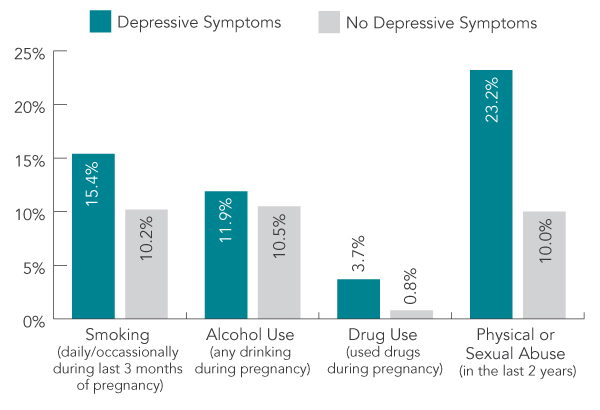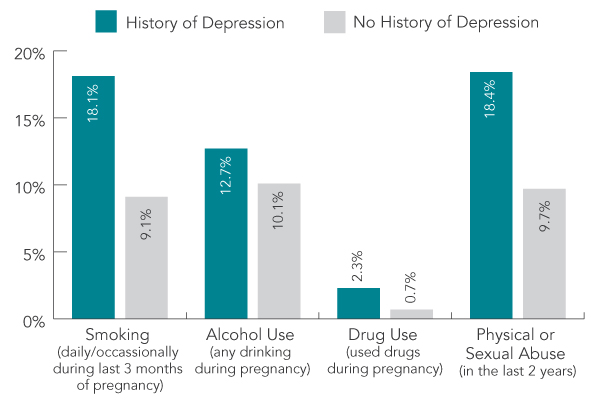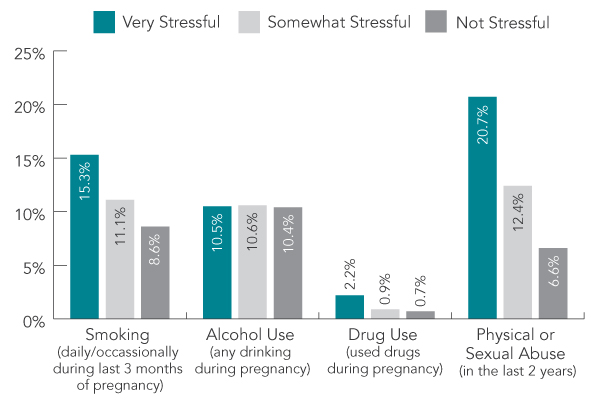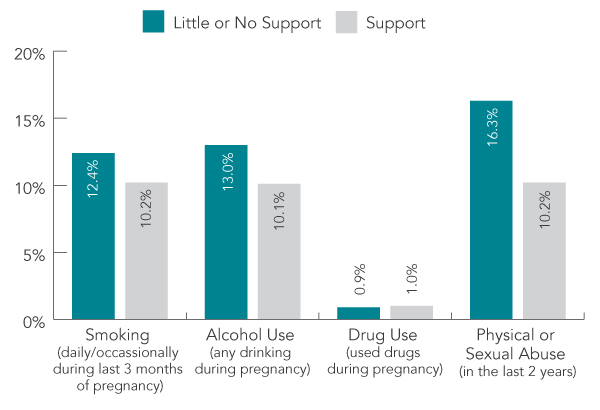Pregnancy and Women's Mental Health in Canada
Results from the Canadian Maternity Experiences Survey
Summary
- In the postpartum period, 7.5% of women reported depressive symptoms.
- Before they became pregnant, 15.5% of women were either diagnosed with depression or treated with anti-depressants.
- In the 12 months before childbirth, 12.5% of women reported that most days were very stressful.
- Some women (13%) had little or no support available to them during their pregnancy.
- Women who experienced physical or sexual abuse were more likely to report postpartum depressive symptoms, a history of depression, stress, and little or no social support.
Introduction
For most women, pregnancy and birth are a time for celebration. However, this can also be a time of change in a woman’s body and lifestyle, which may increase the risk of poor mental health.
The World Health Organization defines mental health as a “state of well-being in which an individual realizes his or her own abilities, can cope with the normal stresses of life, can work productively and is able to make a contribution to his or her community.”Footnote 1
It is important to assess pregnant women’s mental health because it can affect not only the woman’s health, but also her newborn’s health and development. This fact sheet presents information on four selected indicators of women’s mental health covered in the Canadian Maternity Experiences Survey (MES): postpartum depression, history of depression, stress, and social support.
Four risk factors that are linked to the mental health indicators described above include: smoking, the use of alcohol and non-prescription drugs, and women’s history of physical or sexual abuse.

Download the alternative format
(PDF format, 427 KB, 3 pages)
Postpartum depression
Overall, 7.5% of women reported depressive symptoms during the postpartum period. Women with depressive symptoms were also more likely to smoke, consume alcohol, use non-prescription drugs, and experience physical or sexual abuse than women without these symptoms (Figure 1). For example, although few women reported using non-prescription drugs during pregnancy, four times as many women with depressive symptoms reported this, compared with women without these symptoms (3.7% compared with 0.8%).
Figure 1: Postpartum depressive symptoms as related to four risk factors.

Description - Figure 1
Figure 1: Postpartum depressive symptoms as related to four risk factors.
| Risk factor | Depressive Symptoms | No Depressive Symptoms |
|---|---|---|
| Smoking (daily/occasionally during last 3 months of pregnancy) | 15.4% | 10.2% |
| Alcohol Use (any drinking during pregnancy) | 11.9% | 10.5% |
| Drug Use (used drugs during pregnancy) | 3.7% | 0.8% |
| Physical or Sexual Abuse (in the last 2 years) | 23.2% | 10.0% |
History of depression
In the MES, a history of depression was defined as women who have been diagnosed with depression or prescribed anti-depressants before they became pregnant. Before pregnancy, 15.5% of women overall were either diagnosed with depression or treated with anti-depressants. These women were more likely to smoke, consume alcohol, use non-prescription drugs, and experience physical or sexual abuse than women who had no history of depression or had not been prescribed anti-depressants (Figure 2). For instance, they reported smoking during the last three months of pregnancy almost two times (18.1%) as much as other women (9.1%).
Figure 2: History of depression as related to four risk factors.

Description - Figure 2
Figure 2: History of depression as related to four risk factors.
| Risk factor | History of Depression | No History of Depression |
|---|---|---|
| Smoking (daily/occasionally during last 3 months of pregnancy) | 18.1% | 9.1% |
| Alcohol Use (any drinking during pregnancy) | 12.7% | 10.1% |
| Drug Use (used drugs during pregnancy) | 2.3% | 0.7% |
| Physical or Sexual Abuse (in the last 2 years) | 18.4% | 9.7% |
Self-reported stress
The MES asked women about their levels of stress in the 12 months before their baby was born. Women who reported high levels of stress were more likely to smoke, use non-prescription drugs, and experience physical or sexual abuse than women who reported some or no stress (Figure 3). Overall, 12.5% of women reported that most days were very stressful. Women who reported that most days were very stressful had higher proportion of physical or sexual abuse in the previous two years, with over three times (20.7%) that of women with no stress (6.6%).
Figure 3: Self-reported stress as related to four risk factors.

Description - Figure 3
Figure 3: Self-reported stress as related to four risk factors.
| Risk factor | Very Stressful | Somewhat Stressful | Not Stressful |
|---|---|---|---|
| Smoking (daily/occasionally during last 3 months of pregnancy) | 15.3% | 11.1% | 8.6% |
| Alcohol Use (any drinking during pregnancy) | 10.5% | 10.6% | 10.4% |
| Drug Use (used drugs during pregnancy) | 2.2% | 0.9% | 0.7% |
| Physical or Sexual Abuse (in the last 2 years) | 20.7% | 12.4% | 6.6% |
Social support
Overall, 13% of women had little or no support available to them during their pregnancy. Such women were more likely to smoke, consume alcohol, and experience physical or sexual abuse than women with social support (Figure 4). When asked about the past two years, 16.3% of women with little or no social support reported physical or sexual abuse compared with 10.2% of women with social support.
Figure 4: Social support as related to four risk factors.

Description - Figure 4
Figure 4: Social support as related to four risk factors.
| Risk factor | Little or No Support | Support |
|---|---|---|
| Smoking (daily/occasionally during last 3 months of pregnancy) | 12.4% | 10.2% |
| Alcohol Use (any drinking during pregnancy) | 13.0% | 10.1% |
| Drug Use (used drugs during pregnancy) | 0.9% | 1.0% |
| Physical or Sexual Abuse (in the last 2 years) | 16.3% | 10.2% |
More information
Details about the MES, such as the questionnaire, data tables, and teaching slides are available here: The Canadian Maternity Experiences Survey.
To learn more about positive choices to help ensure a healthy pregnancy, please see the Guide to a Healthy Pregnancy.